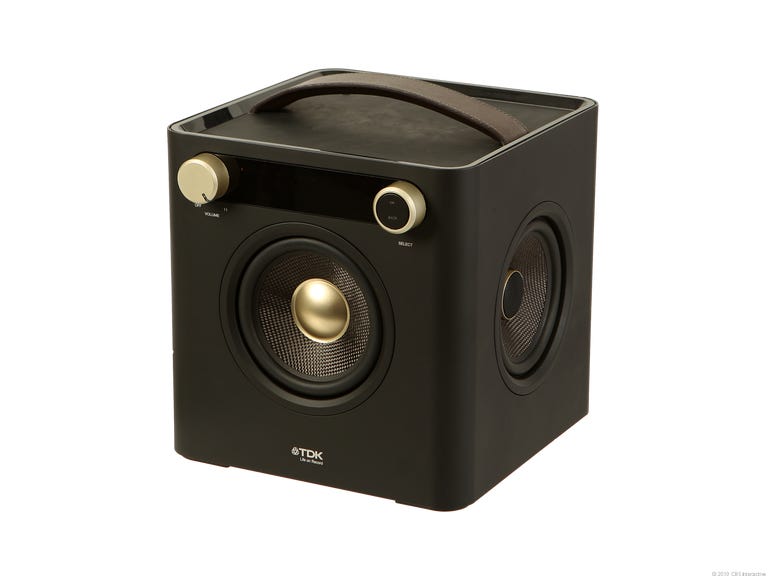TDK is working hard to break away from its history of dusty cassette tapes and make a new name for itself with a line of premium portable speaker systems. The company kicked off 2011 with its TDK 3 Speaker Boombox, which sent us into convulsive fits of retro sonic bliss. For those interested in something more affordable and portable, the TDK Sound Cube ($299) is a more manageable option than its bigger brother, while still holding its own as a great sound system.
The Good
The Bad
The Bottom Line
Design and features
When we call the TDK Sound Cube a boom box, we literally mean that it is designed like a box. There are speakers on each of its sides, a comfy leather handle up on top and a compartment on the bottom with room for 12 D-cell batteries.
Without the batteries inside, the Sound Cube weighs as much as a 12-pack of beer. With the batteries installed, you're in for a workout. Still, it's a much more portable system than its big brother, which was a bit of a shin-smacker.
The audio source, station preset, playback control, and other functions are accessed using illuminated capacitive touch controls located above the front speaker. To the left and right of these buttons are two gloriously oversize aluminum knobs that control volume, radio tuning, and other functions. As on the 3 Speaker Boombox, the volume knob goes to 11.
In spite of our enthusiasm, there are some design disappointments in the TDK Sound Cube. Instead of offering a proper dock or enclosure for your connected iPhone or iPod, the speaker system just has a nonslip padded surface on the top. In fairness, TDK's design decision makes it easier to use with a broad range of audio devices (heck, you could place an old Walkman up there), and makes it more future-proof. Still, a secure space for docking your precious iPhone would be nice.
On the back, the TDK Sound Cube offers an iPhone/iPod connection (via USB), USB stick media playback (MP3, AAC, WMA), and a slew of auxiliary input options, including RCA, minijack, and a quarter-inch instrument input that can be blended with the other audio for instant karaoke and block party high jinks.
It's worth noting that TDK's unique support for iPhone and iPod takes its audio signal from the dock connection's digital output, leaving the digital-to-analog decoding to TDK's integrated converters. The company also throws in an EQ with 5dB of cut and boost, represented on an OLED display on the front and controlled using the system's oversize aluminum knobs.
Radio junkies will appreciate TDK's inclusion of FM radio (though AM would have been nice too), along with five presets. Using the dial on the right, you can tune stations using either a manual control or a seek mode, both of which are a bit slow if you're the type who really likes to blaze through the dial. For supporting broadcasts, station ID and song information text scrolls across the screen.
We're a little disappointed that a speaker system in this price range doesn't offer a remote control (even as an accessory). We also think that TDK's device-agnostic, everything-but-the-kitchen-sink approach should have extended to support for Bluetooth. Had it done so, we wouldn't need to worry about perching devices on the top of the speaker, since they could simply stay in our pockets.
Performance
Under the hood, the TDK Sound Cube includes four 5-inch drivers: a powered woofer at the center and a passive radiator on the back, flanked by two stereo speakers with edge-driven tweeters at their center. Because the speakers aren't covered by a grille, TDK used woven carbon-fiber speaker cones that can stand up to the elements. That said, with a speaker facing in every direction, the odds of one getting poked or spilled on seems inevitable.
Altogether it's 20 watts RMS, which doesn't sound like much, but you feel every watt. Turned up just halfway, it's a house party. With sound shooting out in every direction, it's not a great choice if you're picky about stereo presentation. It isn't the Bose SoundDock competitor that the TDK 3 Speaker Boombox is.
Final thoughts
The TDK Sound Cube is an eye-catching portable speaker system with a generous array of connection options and volume to spare. Its omnidirectional speaker array creates a wide wash of music with a good balance of low end and clarity, but the overall sound and design make it better suited to be a party machine than a home stereo replacement.



